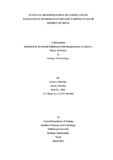Please use this identifier to cite or link to this item:
https://elibrary.tucl.edu.np/handle/123456789/3568Full metadata record
| DC Field | Value | Language |
|---|---|---|
| dc.contributor.author | Chetry, Goma | - |
| dc.date.accessioned | 2021-07-27T10:30:01Z | - |
| dc.date.available | 2021-07-27T10:30:01Z | - |
| dc.date.issued | 2011 | - |
| dc.identifier.uri | http://elibrary.tucl.edu.np/handle/123456789/3568 | - |
| dc.description.abstract | The research was done at Ruru, Thanapati and Digam VDCs of Gulmi district of Nepal in the year 2010. The research work was focused on insect pest of coffee plant in field, their management practices followed by farmers and attitude of coffee growers towards pesticide use. The methods adopted were questionnaire method and direct field observation method. Farmers perception on coffee pest and its management practices was explored through questionnaire method while arthropod pest, its problems and infestation was done by direct field observation. Field observation was done in eight orchards in each site. The observation was focused on the arthropod pests of coffee and damage done by them. The field visit revealed that the major problem of coffee cultivation is White stem borer (Xylotrechus quadripes Chevr.) followed by red stem borer (Zuezera sp.); various defoliators like Catantops sp., Calaposoma semicostatum Jac., Aspidomorpha sanctai crucis Fab., Anomala sp.; Various sap suckers like Toxoptera aurantii Boyer, Leptocorisa sp., Scale insects, Aspangopus sp.; and white grub (Holotrichia sp.) as root destroyer. According to farmers perception White stem borer followed by Red stem borer was the most problematic insect pests of coffee while other insect pests were the minor one because their loss were negligble as compair to the stem borers. White stem borer (Xylotrechus quadripes Chevr.) usually attack older plants. If the white stem borer problem could not managed propely it will destroy the coffee plant in district totally. For the control of pest locally available botanical based pesticides are made by all farmers themselves having pesticidal propeties. Other management practices such as insect sex pheromone trape, light trape and other mechanical methods were also being used by some of the farmers in their coffee orchards. Generally farmers uproot whole infested plants and destroy them when all the management strategies are failed. Although 8.33 % of farmers have negative attitude towards the organic farming while 91.67 % of farmers have positive attitude towards the organic farming. | en_US |
| dc.language.iso | en_US | en_US |
| dc.publisher | Central Department of Zoology | en_US |
| dc.subject | Management techniques | en_US |
| dc.subject | Organic Farming | en_US |
| dc.title | Status of Arthopodan Pest of Coffee and its Management Techniques in Organic Farming in Gulmi District of Nepal | en_US |
| dc.type | Thesis | en_US |
| local.institute.title | Central Department of Zoology | en_US |
| local.academic.level | Masters | en_US |
| Appears in Collections: | Zoology | |
Files in This Item:
| File | Description | Size | Format | |
|---|---|---|---|---|
| Thesis Zoology_Goma 2011.pdf | 4.74 MB | Adobe PDF |  View/Open |
Items in DSpace are protected by copyright, with all rights reserved, unless otherwise indicated.
